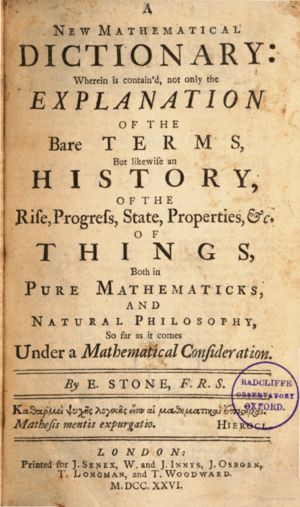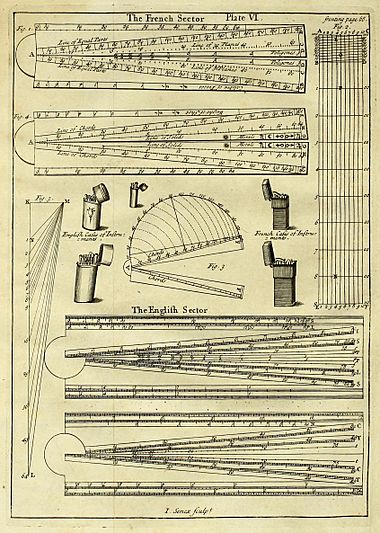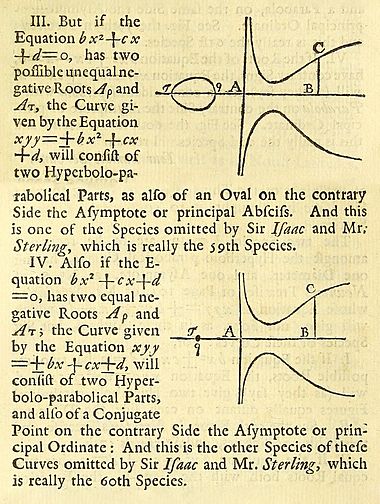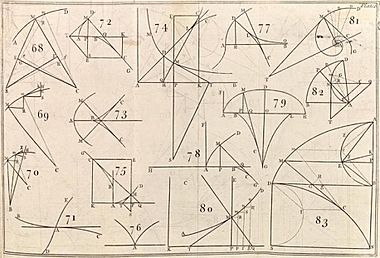Edmund Stone facts for kids
Quick facts for kids
Edmund Stone
|
|
|---|---|

A New Mathematical Dictionary (1726)
|
|
| Born | c. 1690 unknown, likely Argyllshire, Scotland
|
| Died | March or April 1768 unknown
|
| Scientific career | |
| Fields | Mathematics |
| Patrons | John Campbell, 2nd Duke of Argyll |
Edmund Stone (around 1690 – March or April 1768) was a Scottish mathematician. He taught himself everything he knew. He lived in London and mostly worked as an editor and translator of math and science books.
He is famous for translating important books from French and Latin into English. These include Nicholas Bion's Mathematical Instruments (1723, 1758) and Marquis de l'Hospital's Analyse des Infiniment Petits (1730). He also wrote his own book, New Mathematical Dictionary (1726, 1743). People admired Stone because he started as a gardener's son with no education but became a respected scholar.
Edmund Stone's Life Story
We don't know exactly when or where Edmund Stone was born. We also don't know his parents' names. He was likely born in Argyllshire, Scotland, before 1700.
Most of what we know about his early life comes from a letter. It says that Stone was the son of the gardener for John Campbell, 2nd Duke of Argyll. He never went to school. At age 18, a servant taught him to read. After that, he taught himself math, geometry, Latin, and French.
The story goes that the Duke found a copy of Isaac Newton's famous book, Principia, in his garden. He was amazed to find out it belonged to 28-year-old Stone. Even more surprising, Stone understood the Latin and advanced math in the book. However, Stone himself said he had studied mathematical instruments since he was twelve. This makes the story a bit unclear. The Duke became his supporter and helped him.
With the Duke's help, Stone moved to London around 1720. He probably worked there as a math tutor. In 1723, he published a translation of Nicholas Bion's Construction and Principal Uses of Mathematical Instruments. He added details about English versions of the tools Bion described. This book became a very important reference in English for many years.
In 1725, Stone became a Fellow of the Royal Society. This is a very respected group for scientists. He also worked for the Board of Green Cloth for many years. His New Mathematical Dictionary came out in 1726. It was a cheaper choice compared to other similar books. He also translated Euclid's Elements (1728). He translated l'Hospital's book on differential calculus (1730) and added his own part on integral calculus. He also translated Isaac Barrow's Geometrical Lectures (1735).
In 1736, Stone wrote a paper about two special curves. These curves had not been listed by Isaac Newton or James Stirling. However, other mathematicians had already published them a few years earlier. In 1742, Stone wrote another paper about Isaac Newton's parabolas. It was read to the Royal Society but was never published.
In 1742, Stone left the Royal Society. This might have been because he couldn't pay the small yearly fee. In 1743, his supporter, the Duke of Argyll, passed away. We don't know much about Stone's life after this. He did another translation of Euclid's Elements in 1752. He also published a second edition of Bion's Mathematical Instruments in 1758. This new edition included a long section about new discoveries.
In 1760, a writer named Tobias Smollett wrote about Stone. He said that Stone was very talented and respected. Yet, he lived to be old without much reward, except for a small job. In 1766, Stone published a book that questioned the idea that Earth is perfectly round. He suggested that Earth might be an irregular, roundish shape with many flat sides. Edmund Stone died in March or April 1768.
Edmund Stone's Books

- 1720, An Analytick Treatise of Conick Sections: This was a translation of a book by the Marquis de l'Hospital about conic sections.
- 1721, The Description, Nature and General Use, of the Sector and Plain-scale: This book was about how to use a sector and a plain-scale.
- 1721, Clavius's Commentary on the Sphericks of Theodosius Tripolitae: or, Spherical Elements: A translation of a Latin book by Christopher Clavius about Theodosius's Spherics.
- 1723, The Construction and Principal Uses of Mathematical Instruments: A translation of Nicolas Bion's book. Stone added details about English versions of the tools. He published a second edition in 1758 with new information.
- 1724, An Essay on Perspective translated from Willem 's Gravesande's book.
- 1726, A New Mathematical Dictionary: His own dictionary of mathematical terms. A second edition came out in 1743.
- 1728, Euclid's Elements of Geometry, Briefly, yet Plainly Demonstrated: A translation of Isaac Barrow's Latin version of Euclid's Elements.
- 1730, The Method of Fluxions, both Direct and Inverse: The first part was translated from l'Hospital's book on differential calculus. Stone wrote the second part about integral calculus.
- 1735, Geometrical Lectures: Translated from Isaac Barrow's book.
- 1743, The Theory of the Working of Ships, Applied to Practice: A translation of Henri Pitot's book about how ships work.
- 1752, Euclid's Elements of Geometry, The First Six, the Eleventh and Twelfth Books: Another translation of parts of Euclid's Elements. A second edition was published in 1765.
- 1766, Some Reflections on the Uncertainty of Many Astronomical and Geographical Positions: A book where Stone discussed his ideas about the shape of the Earth.



